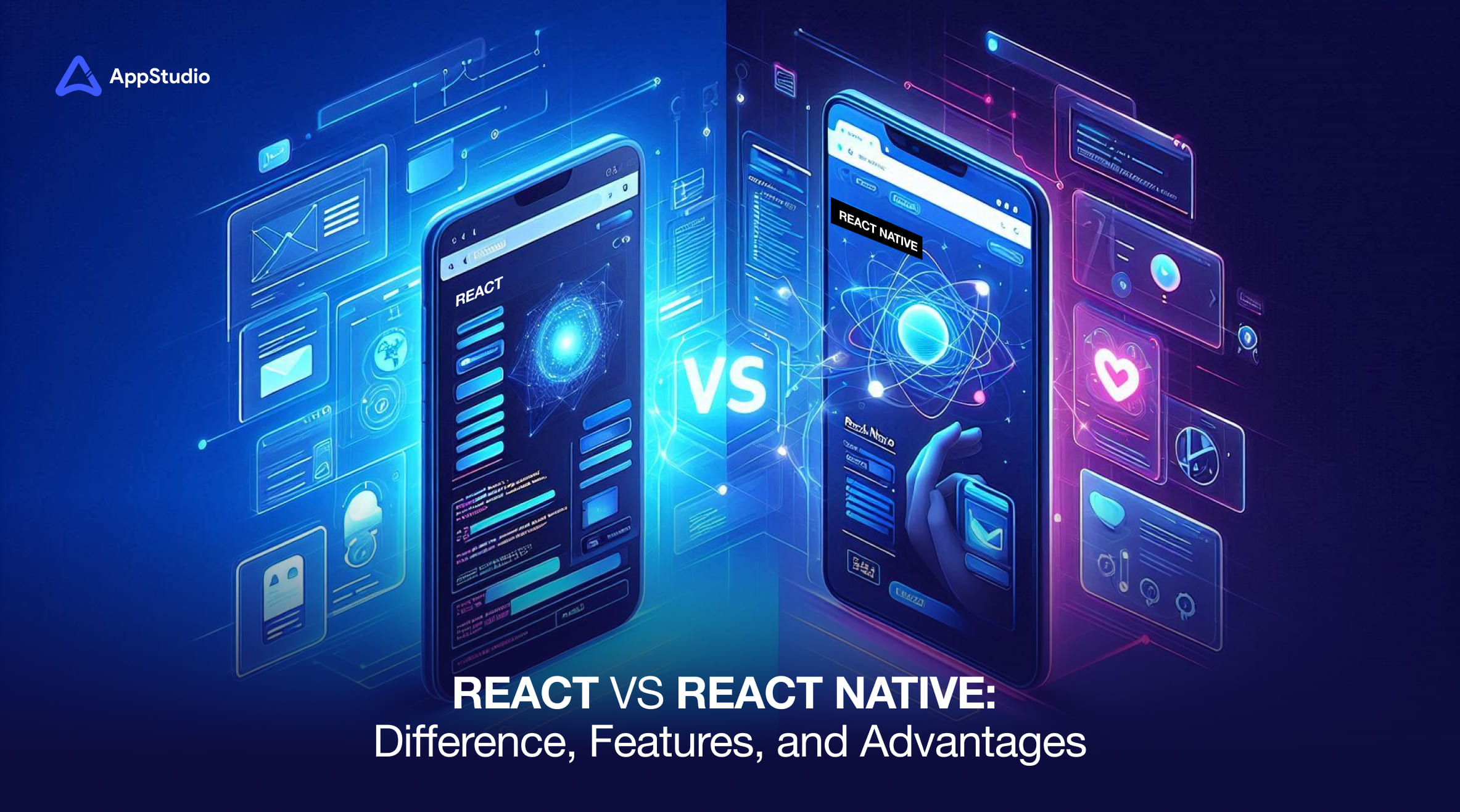The world of web and mobile app development has witnessed a revolution over the past decade, with JavaScript taking center stage as a versatile language for building both dynamic user interfaces and native mobile applications. Among the tools and frameworks that have gained immense popularity, React and React Native stand out due to their efficiency, performance, and ease of use. Despite sharing a similar name, React and React Native serve very different purposes, and understanding the difference between the two is crucial when deciding which to use for your next project.
In this comprehensive guide, we’ll dive deep into what React and React Native are, how they work, their advantages and disadvantages, and key factors to consider when choosing between them.
What is React?
React is an open-source JavaScript library for building user interfaces (UIs). Developed and maintained by Facebook, it allows developers to create single-page applications (SPAs) with interactive and dynamic user interfaces. React emphasizes a component-based architecture, meaning UIs are broken down into smaller, reusable components, making development more efficient and maintainable.
Related reading:A Beginner’s Guide to React Native App Development
How does React work?
React is built around the concept of components. Each component manages its own state and renders the appropriate UI based on that state. React uses a Virtual DOM to optimize the rendering process. The Virtual DOM is a lightweight copy of the real DOM. When changes occur in the state of a component, React updates the Virtual DOM first. It then compares this Virtual DOM with the real DOM and updates only the parts that have changed, making the process faster and more efficient than traditional DOM manipulation.
When to use React?
You should use React when building web applications that require a dynamic and interactive user interface. It’s particularly useful for:
- Single-page applications (SPAs) where real-time updates are essential.
- Complex web applications that involve constant data updates or interactive elements, like dashboards or social media platforms.
- Websites that need to be SEO-friendly (React can be rendered on the server for better SEO).
Advantages of React
- Component-Based Architecture: React’s modular approach encourages reusability and maintainability. Each component can be reused throughout the application, making development more efficient.
- Virtual DOM for Better Performance: The Virtual DOM ensures faster rendering and improved performance by minimizing direct manipulations of the real DOM.
- Declarative Syntax: React’s declarative nature makes the code more predictable and easier to debug. Developers describe what the UI should look like for a given state.
- Strong Community and Ecosystem: React has a large, active community, meaning there’s a wealth of resources, tutorials, and libraries that developers can leverage.
- SEO-Friendliness: React’s ability to render server-side enables it to be search-engine friendly, which is crucial for web apps that need to be indexed by search engines.
Disadvantages of React
- Steep Learning Curve for Beginners: While React simplifies many aspects of web development, beginners may struggle with advanced concepts like hooks, Redux, or React Router.
- Only Handles the UI: React is just a UI library, which means you’ll need to combine it with other libraries or frameworks (e.g., Redux for state management) to build a complete application.
- Frequent Updates: React is frequently updated, and while this is great for improvements, it can be challenging for app developers to keep up with changes and new features.
- Not Ideal for Complex Animations: While React excels at building complex UIs, handling complex animations requires third-party libraries or native solutions.
Related reading: All-In-One Guide To Pick The Best React Native Experts
What is React Native?
React Native is a framework based on React that allows developers to build mobile applications for both Android and iOS using JavaScript and React. Unlike traditional mobile app development approaches, React Native enables the creation of mobile apps using native components (like View, Text, Button), rather than web-based components (like div or span). This approach provides a more native-like experience, with the ability to access platform-specific APIs, such as the camera, GPS, or contacts.
How does React Native work?
React Native bridges the gap between JavaScript code and native mobile code. Developers write JavaScript code, which is then converted into native code by the React Native runtime. The core components of React Native (like Text, View, etc.) are rendered using native elements, ensuring that the app performs similarly to a traditional native app. React Native also allows developers to integrate native code (written in Java, Swift, or Objective-C) when necessary for performance-critical operations or to access specific native features.
When to use React Native?
Use React Native when you need to develop a cross-platform mobile application for both Android and iOS. React Native is ideal for:
- Mobile applications that need native-like performance and UI components.
- Projects that require the use of native APIs (like the camera, GPS, or accelerometer).
- Developers familiar with JavaScript who want to build apps for mobile platforms without learning platform-specific languages like Java or Swift.
Advantages of React Native
- Cross-Platform Development: Write once, run anywhere! React Native allows you to create apps for both Android and iOS from a single codebase, saving time and resources.
- Near-Native Performance: React Native delivers near-native performance due to the use of native components for rendering UI.
- Live and Hot Reloading: These features allow developers to immediately see the changes they’ve made without restarting the app, which speeds up development.
- Large Ecosystem and Community: React Native shares React’s active community and wealth of resources, making it easier for developers to find solutions to common problems.
- Access to Native APIs: React Native provides direct access to platform-specific APIs, allowing developers to take full advantage of device capabilities, such as camera, geolocation, and notifications.
Disadvantages of React Native
- Performance Limitations: While React Native offers near-native performance, it may not be suitable for apps with heavy computational needs or complex animations, where fully native solutions are preferable.
- Complex Native Modules: For certain features, you may need to write native code in Java or Swift, which can add complexity and reduce the benefits of using a cross-platform framework.
- Limited Third-Party Libraries: Although React Native has a growing ecosystem, it may lack support for certain third-party libraries or platform-specific features.
- UI Consistency Issues: UI components can behave slightly differently on Android and iOS, and developers might need to write additional platform-specific code to ensure consistency.
Similarities between React and React Native
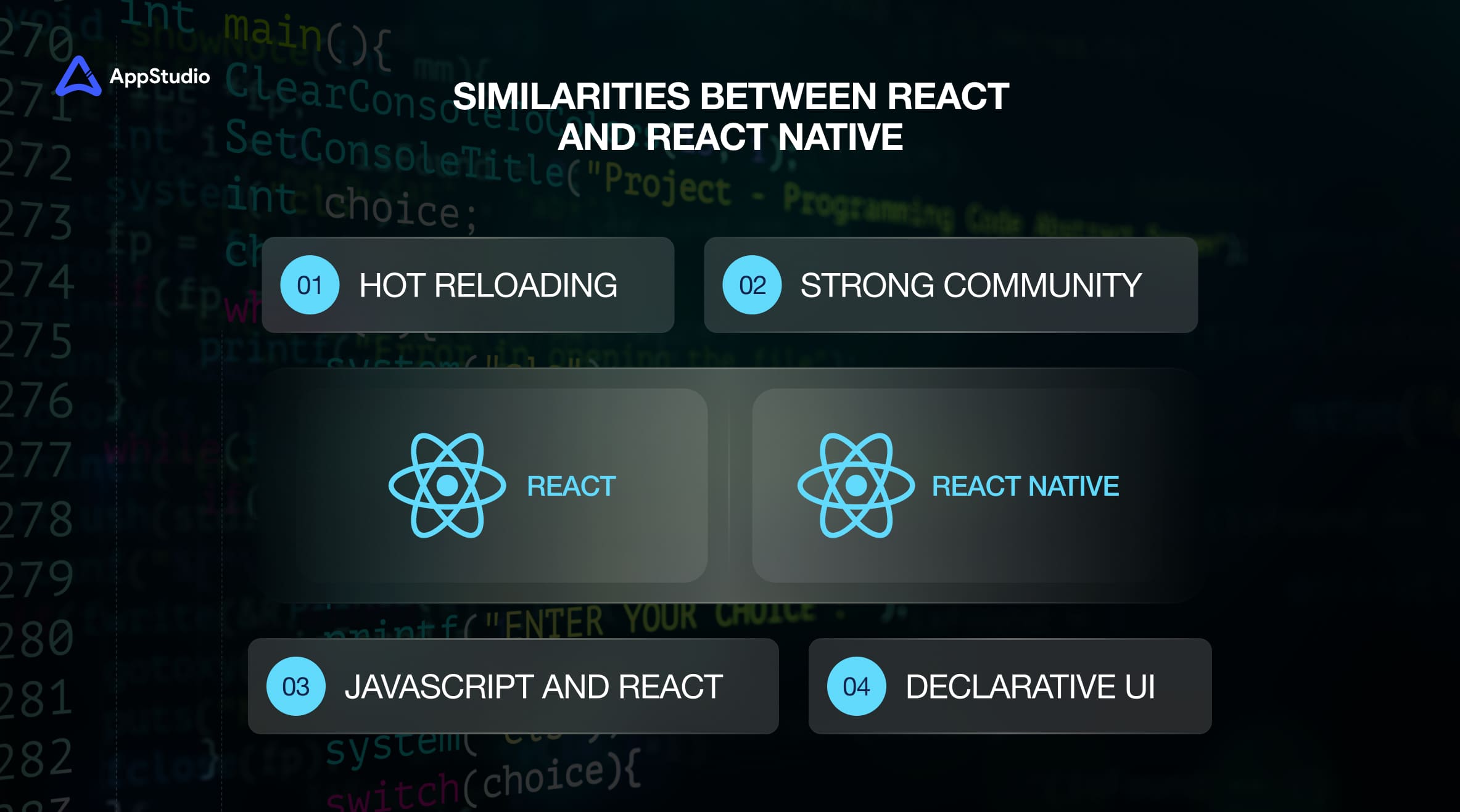
React and React Native share many similarities, especially in terms of their core principles and design patterns:
- JavaScript and React: Both use JavaScript and React’s component-based architecture.
- Declarative UI: Both React and React Native promote a declarative approach to defining UIs, making it easier to reason about how the UI should look and behave at any given time.
- Hot Reloading: Both platforms support hot reloading, enabling developers to instantly see the changes they make to the code.
- Strong Community: Both React and React Native are backed by large, active communities, ensuring developers have access to plenty of resources, libraries, and third-party tools.
Related reading: Top 7 Mistakes to Avoid While Developing React Native Apps
Difference Between React and React Native
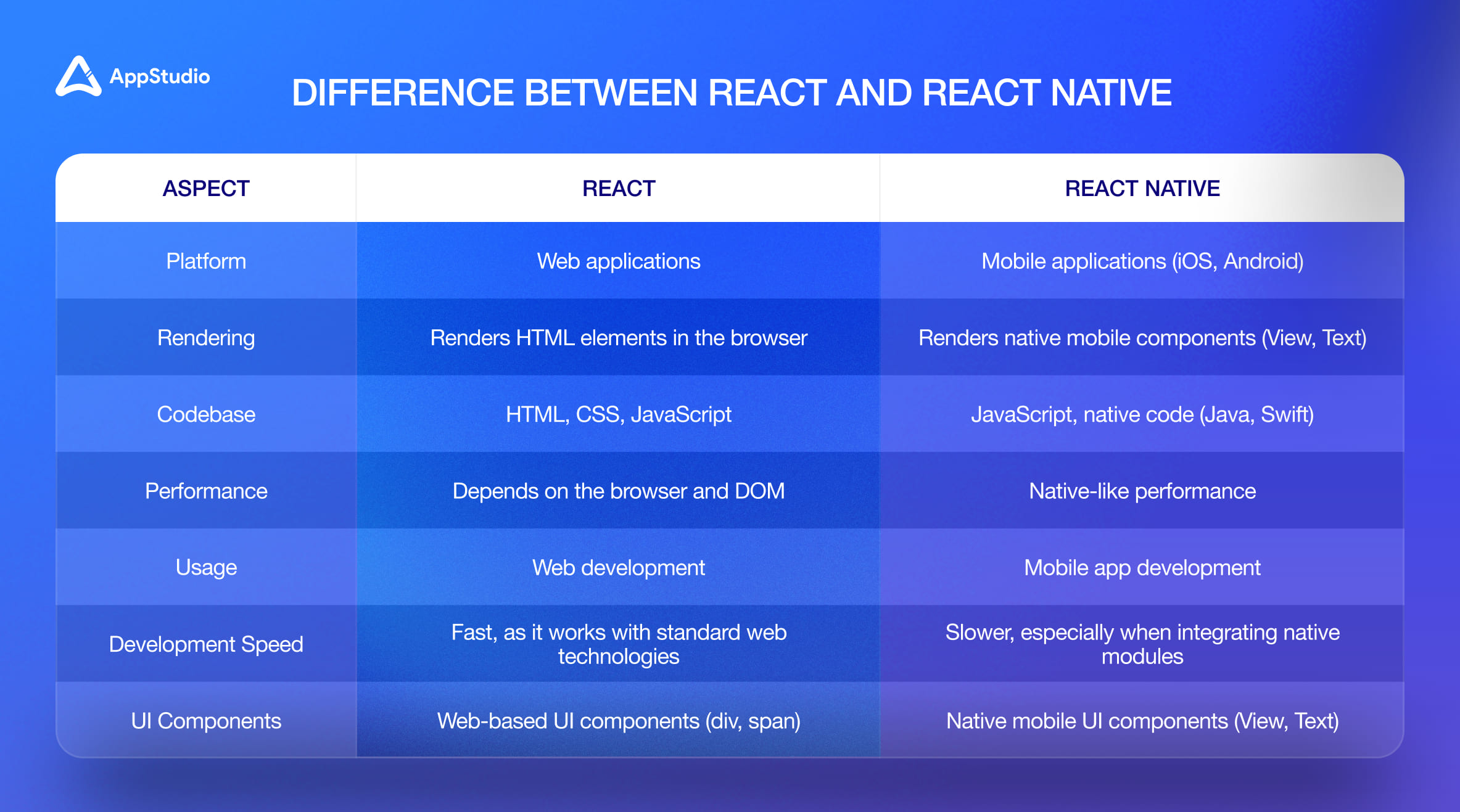
While React and React Native share similarities, they are designed for very different use cases:
| Aspect | React | React Native |
| Platform | Web applications | Mobile applications (iOS, Android) |
| Rendering | Renders HTML elements in the browser | Renders native mobile components (View, Text) |
| Codebase | HTML, CSS, JavaScript | JavaScript, native code (Java, Swift) |
| Performance | Depends on the browser and DOM | Native-like performance |
| Usage | Web development | Mobile app development |
| Development Speed | Fast, as it works with standard web technologies | Slower, especially when integrating native modules |
| UI Components | Web-based UI components (div, span) | Native mobile UI components (View, Text) |
| Learning Curve | Moderate to steep for beginners | Moderate, but requires knowledge of native modules for complex features |
ReactJS Vs React Native: Which to Choose & When?
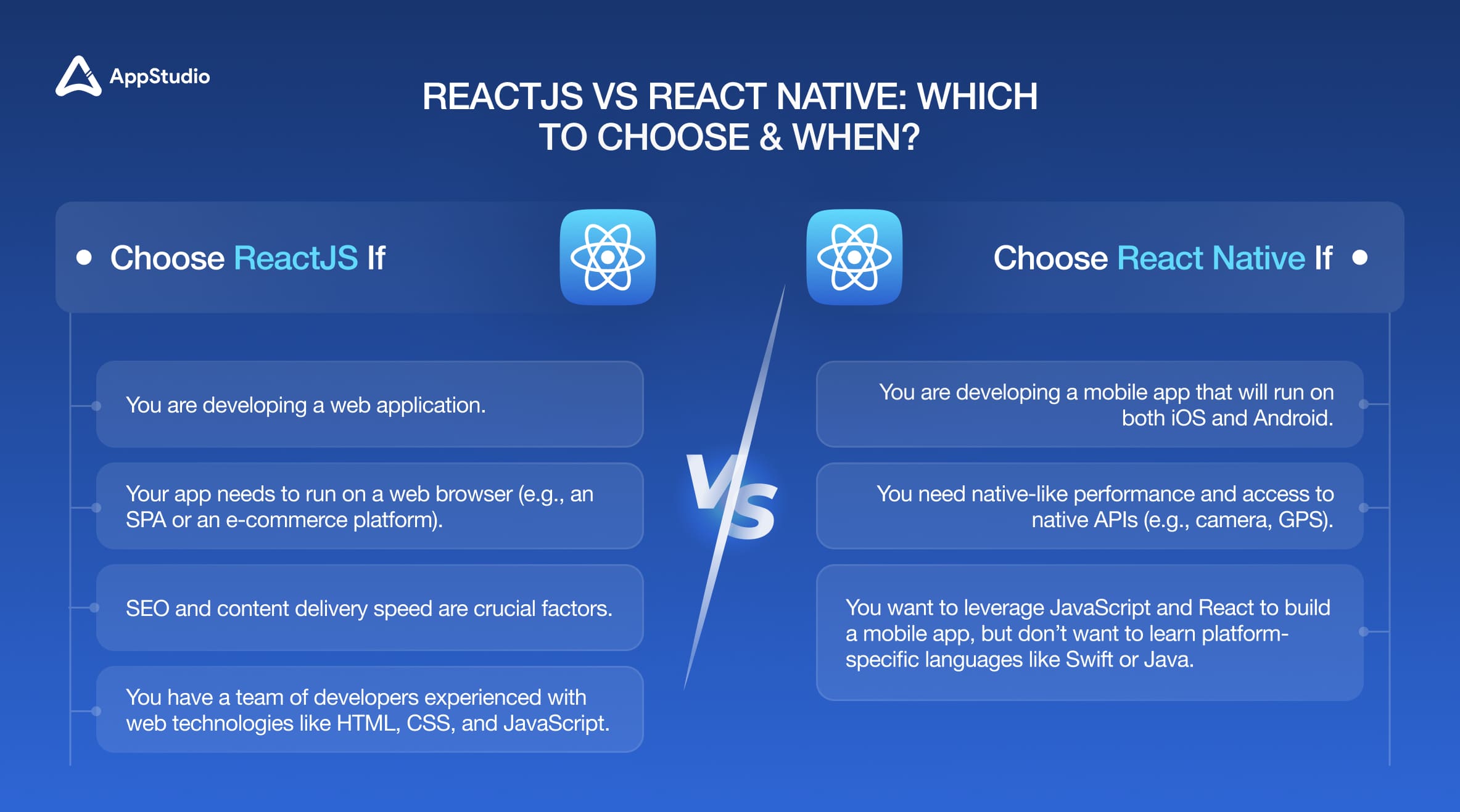
The choice between ReactJS and React Native largely depends on your project requirements. Here’s a quick guide to help you choose the right tool:
- Choose ReactJS if:
- You are developing a web application.
- Your app needs to run on a web browser (e.g., an SPA or an e-commerce platform).
- SEO and content delivery speed are crucial factors.
- You have a team of developers experienced with web technologies like HTML, CSS, and JavaScript.
- Choose React Native if:
- You are developing a mobile app that will run on both iOS and Android.
- You need native-like performance and access to native APIs (e.g., camera, GPS).
- You want to leverage JavaScript and React to build a mobile app, but don’t want to learn platform-specific languages like Swift or Java.
Factors to Consider When Choosing Between React and React Native
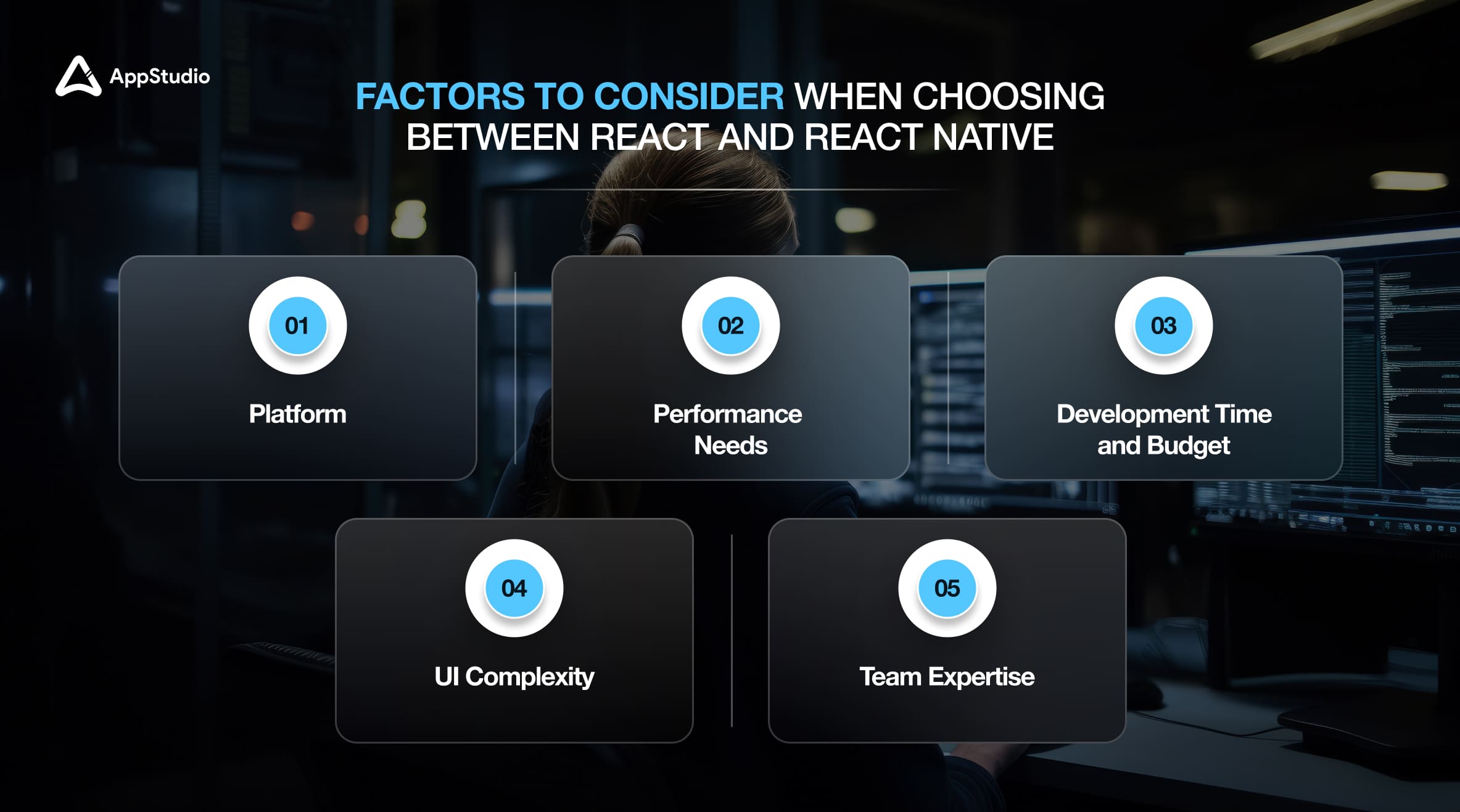
- Platform: If you’re building a web application, React is the obvious choice. If you’re focusing on mobile app development, React Native is the way to go.
- Performance Needs: For mobile apps requiring high-performance or heavy computation (e.g., gaming apps), native solutions might be better than React Native.
- Development Time and Budget: React Native’s ability to build cross-platform apps with a single codebase can save time and costs compared to building separate apps for Android and iOS.
- UI Complexity: For highly complex UIs with intricate animations, React may perform better in the web space, while React Native may require extra effort to optimize animations for mobile.
- Team Expertise: If your team is experienced in web development, React may be a faster choice. If they’re already familiar with React but want to build mobile apps, React Native could be more appropriate.
Related reading: React Native Pros and Cons for Mobile App Development
Conclusion
In the end, both React and React Native are powerful tools in the developer’s toolkit, and the decision between the two depends on the platform and type of application you’re developing. React is ideal for building fast, dynamic web applications, while React Native is perfect for developing mobile apps with near-native performance. Understanding their features, advantages, and disadvantages will help you make an informed decision and select the best framework for your next project.
Want to build a cross platform application? Get in touch with react native experts at AppStudio- your go-to cross platform app development company
Frequently Asked Questions
The main difference between React JS and React Native lies in their platform and usage. React JS is a JavaScript library used to build dynamic user interfaces for web applications, while React Native is a framework that allows developers to create mobile applications for both iOS and Android using JavaScript and React. In simple terms, React JS vs React Native comes down to web development versus mobile app development.
If you’re building a web application or single-page application (SPA), you should choose React JS. It’s ideal for creating interactive web UIs where SEO and faster page loads are important. On the other hand, React Native vs React JS would push you toward React JS if you’re targeting a browser-based platform with rich dynamic content, especially when performance demands aren’t as high as in mobile apps.
One of the top advantages of React JS is its focus on web development, providing efficient ways to build dynamic and SEO-friendly websites. With React’s Virtual DOM, web apps can render faster and more efficiently. Moreover, React’s large ecosystem and support for a vast number of third-party libraries make it an excellent choice for developers looking to build sophisticated web applications. On the other hand, React Native may not offer as much flexibility for web development purposes, especially when it comes to complex UI designs or browser-specific features.
One of the primary disadvantages of React Native is its performance compared to fully native applications. While React Native offers near-native performance, it can still fall short in situations where performance is critical, such as with apps that require complex animations or heavy computational power. Moreover, developers may need to write native code (like Java or Swift) for certain advanced features, which adds complexity. This makes React Native vs React JS more advantageous for simple mobile apps but less ideal for heavy, performance-intensive mobile applications.
Yes! It’s possible to use both React JS and React Native in a single project, especially when you’re building a web and mobile application for the same platform. For example, you could develop the web version of your app using React JS and the mobile version using React Native. Both share a similar component-based architecture, so your development team can use the same skills across both platforms. This approach is especially beneficial in projects aiming for a cross-platform strategy. The React Native vs React JS differences in rendering won’t pose much of a challenge due to their shared principles.
React JS vs React Native has a significant impact on app performance due to their different rendering processes. React JS performs well in a browser-based environment and excels at handling web page updates efficiently with its Virtual DOM. However, when it comes to mobile applications, React Native shines. By leveraging native components and APIs, React Native offers near-native performance, which is typically faster and smoother than hybrid mobile solutions. That said, React JS is better suited for web applications, where the demand for native-like performance isn’t as critical as in mobile app development.
